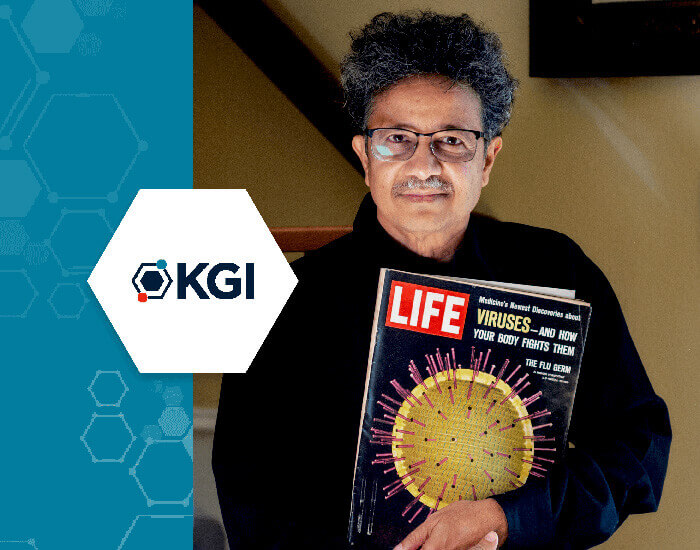Loam Bio Pty. Ltd., an Australia/U.S. company with a focus on reducing atmospheric carbon dioxide through innovative agricultural practices, has funded research at Keck Graduate Institute Professor Dr. Animesh Ray‘s laboratory on understanding the role of soil fungi in carbon assimilation within the soil microbial ecosystem. The Ray laboratory has been leveraging its genomics and systems biology expertise in continuing collaboration with Loam Bio.
Loam Bio had previously supported a year-long Team Master’s Project (TMP) at KGI in 2020-21 and a three-month pilot project in 2021 in Ray’s laboratory. The company currently sponsors KGI PhD in Applied Life Sciences student Tristan Yang, who is working in collaboration with Ray.
“Students at KGI are interested in more than just an advanced degree; they want to make a difference in the world,” said Shannon Braun, senior director of corporate partnerships for KGI.
“This collaboration connects KGI and our students to science that can indeed have an impact in their lifetime and highlights how the skills gained at KGI can be used outside our more traditional outcomes—roles in the life science industry and healthcare.”
This new funding from Loam Bio will help cement the emerging effort at KGI by Ray and Dr. Ilya Tolstorukov, KGI research professor, on reducing the burden of anthropogenic carbon (carbon associated with human activities, including the burning of fossil fuels, deforestation, and fertilization) on the atmosphere.
Ray has had a personal and professional relationship with Dr. Abed Chaudhury, the Head of Scientific Innovation for Loam Bio, for more than 40 years. Chaudhury retired early from Australia’s Commonwealth Scientific and Industrial Research Organisation to conduct innovative field studies in agricultural biotechnology. He eventually joined forces with Guy Hudson, the Co-Founder, and CEO of what is now Loam Bio.
While the atmosphere contains too much carbon—contributing heavily to the greenhouse effect—the soil contains too little carbon. Loam Bio started when a group of farmers discovered that a large fraction of atmospheric carbon dioxide could be trapped in the soil by microbial fungi, thus reducing atmospheric carbon while improving soil health as carbon influences the infiltration and storage of water, drives nutrient cycles, and eases dependence on fertilizers.
“Bacteria and nematodes within the soil interact with the fungi and plant roots, making a very complex ecosystem—which plays an essential role in carbon flow,” Ray said. “Some studies have demonstrated through small-scale experiments that it is possible to manipulate this microbial ecosystem to reduce the outflow of carbon dioxide and other greenhouse effect gasses such as methane, which contributes nearly 40 times as much to the greenhouse effect compared to carbon dioxide on a per mass basis.”
Loam Bio uses biotechnology to enhance these natural processes, utilizing microbial carbon sequestration. Microbial processes are more efficient than other means of capturing carbon because they do not require additional equipment, land, or energy.
Ray comes from similar roots as Chaudhury, having earned his PhD in microbial genetics from Melbourne’s Monash University. As a professor, research in his laboratory led to the discovery of the first known maternal effect embryo pattern formation gene in plants. From 1999 to 2001, he directed research programs on regulating gene expression and gene targeting at a plant biotechnology start-up in San Diego.
Thus, when Chaudhury approached Ray to see if he could help organize research to assist the bioinformatics team of Loam Bio, it seemed like a natural fit.
“They sponsored a TMP, which was wildly successful,” Ray said. “Our TMP got the best team award in 2021 at KGI. With the help of the students, we set up Loam Bio’s main computational group.”
KGI student Yang, MBS ’21, PhD ’24, served as the lead for the TMP. He now works full-time for Loam Bio as a bioinformatics specialist. In September 2021, Yang joined Ray’s lab as a sponsored PhD student, furthering their efforts to better understand how soil fungi can contribute to carbon assimilation.
Initially, Loam Bio funded a 2021 pilot project in Ray’s lab to determine whether some computationally-predicted metabolomic pathways that may participate in carbon sequestration in the soil exist.
“Then they came up with more extensive funding for the next six months to advance this to a more practical level,” Ray said. “If we succeed at this stage, we will consider further funding.”
Loam Bio’s goal is to utilize the information to ultimately enhance plant productivity while reducing carbon in the atmosphere. This would be a win for both the environment and food production.
